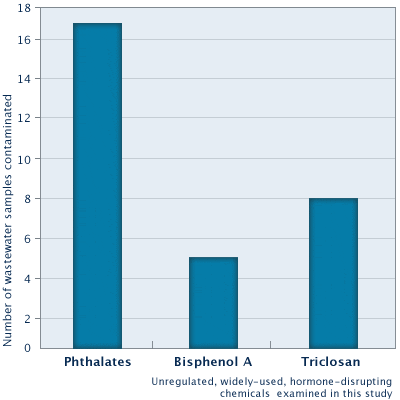Sources of Hormone-Disrupting Chemicals in San Francisco Bay
95 Percent of Wastewater Samples Show Widespread Use of Chemicals
By Rebecca Sutton, PhD, July 2007
http://www.ewg.org/reports/downthedrain
Advances in technology allow an unprecedented look at chemical contaminants in water bodies throughout the United States. In 2002, the first nationwide study of man-made chemicals and hormones in 139 streams revealed that 80 percent of streams tested were contaminated Kolpin 2002). Several of the chemicals examined are known or suspected of disrupting the hormone systems of animals and people. Of these, only a small fraction have been regulated at all, much less tested for toxicity, persistence in the environment, or other harmful characteristics, such as hormone disruption. Some of the same unregulated, widely-used, hormone-disrupting chemicals have been detected at trace levels in the San Francisco Bay (Oros 2002).
Fish and other aquatic life inhabiting waters containing man-made hormone-disrupting chemicals may develop reproductive and other health disorders. For example, male fish with immature eggs in their testes have been documented with increasing frequency throughout the U.S. (Pait 2002; Goodbred 2007). Damage to the reproductive health of vulnerable fish populations may result in detrimental consequences to local fisheries and aquatic ecosystems; in addition, there is concern that people could become further exposed to hormone-disrupting chemicals by eating contaminated fish (Houghton 2007).
To identify some of the sources of these hormone-disrupting chemicals, Environmental Working Group (EWG) and East Bay Municipal Utility District (EBMUD) researchers analyzed samples of wastewater from residential, commercial, and industrial sites in the San Francisco Bay Area. 18 of 19 wastewater samples examined contained at least 1 of 3 unregulated, widely-used hormone disruptors – phthalates, bisphenol A, and triclosan; 2 samples contained all 3 substances. Despite sophisticated wastewater treatment, these chemicals were detected in treated waters discharged into the Bay.

Analysis of 19 wastewater samples for 3 hormone-disrupting substances reveals widespread contamination.
While wastewater treatment is extremely effective in removing biodegradable food and human waste, it was never designed to address this broad spectrum of unregulated chemical pollution. Advances in wastewater treatment may reduce some types of pollution, but new chemicals are introduced continuously into the marketplace. Expensive potential improvements to wastewater treatment facilities would result in higher consumer water rates, while only removing a fraction of these contaminants of concern. Instead, it is critical to look at more cost-effective ways to protect our waterways through reducing chemical pollution at the source – before it ever reaches the treatment plant or the Bay.
for complete article: http://www.ewg.org/reports/downthedrain